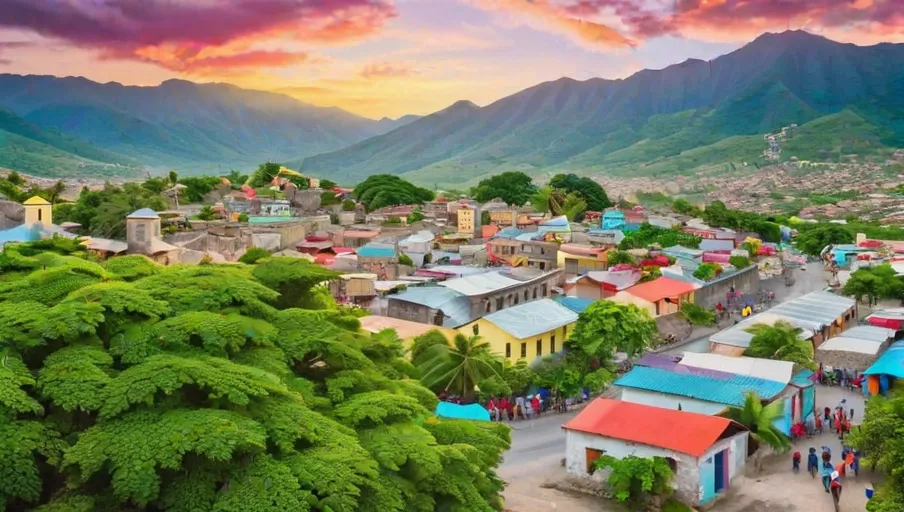
Are you up for a challenge that will test your geography skills? In this article, we present a quiz that will put your knowledge of Haitian cities to the test.
Haiti, located in the Caribbean, is a culturally rich country with vibrant cities. By participating in this quiz, you will have the opportunity to expand your understanding of Haitian geography and become familiar with notable cities such as Cap-Haïtien, Léogâne, and Port Salut.
So, let’s see if you can accurately locate these 12 Haitian cities on the map!
- The article provides information about various cities and communes in Haiti, including their locations and historical significance.
- The quiz mentioned in the article allows readers to test their knowledge and understanding of Haitian culture and geography.
- The article also highlights the culinary delights of Haiti and provides a foodie guide to the capital city.
- Overall, the article aims to educate readers about Haiti’s cities, culture, and geography while also providing an interactive quiz and information about the country’s cuisine.

Cap-Haïtien, located in the northern part of Haiti, is one of the 12 Haitian cities that can be tested in the geography quiz. This historically significant city has a rich history and is home to several landmarks that attract tourists from all over the world.
One of the top attractions in Cap-Haïtien is the Citadelle Laferrière, a UNESCO World Heritage site and the largest fortress in the Americas. Visitors can explore the fortress and learn about its role in Haiti’s fight for independence.
Another popular landmark in Cap-Haïtien is the Sans-Souci Palace, once the residence of King Henri Christophe. The palace showcases stunning architecture and offers a glimpse into Haiti’s past.
In addition to these historical landmarks, Cap-Haïtien also offers beautiful beaches, vibrant markets, and delicious local cuisine, making it a must-visit destination for those exploring Haiti.

Jérémie, situated in the southwestern region of Haiti, showcases a unique blend of culture and history. This vibrant city is known for its rich cultural heritage as well as its historical significance.
Exploring the history and cultural significance of Jérémie, Haiti:
The indigenous Tano people, European colonization, and African influences all played a role in shaping Jérémie’s fascinating history. The city’s architecture, music, and cuisine reflect this diverse heritage, making it a cultural hub in Haiti.
The impact of natural disasters on Jérémie’s infrastructure and economy:
Jérémie has faced numerous challenges, particularly from natural disasters like hurricanes and earthquakes.
These events have had a devastating impact on the city’s infrastructure, including buildings, roads, and utilities. With crops destroyed by hurricanes and floods, the economy, which is heavily dependent on agriculture, has also suffered.
Despite these challenges, Jérémie continues to be a resilient and vibrant city, with its history and cultural significance attracting visitors from around the world. Efforts are being made to rebuild and strengthen the city’s infrastructure, ensuring a brighter future for Jérémie and its people.

Milot’s historic Sans-Souci Palace, along with its rich cultural heritage, attracts tourists and historians alike. Located in the northern part of Haiti, Milot is a must-visit destination for those interested in exploring the history and attractions of Haiti.
The city holds great significance in Haitian culture, as it was the former capital of the Kingdom of Northern Haiti during the reign of King Henri Christophe. The Sans-Souci Palace, built in the early 19th century, showcases the architectural grandeur of that era and offers a glimpse into the country’s past.
Additionally, Milot boasts a picturesque landscape with lush mountains and breathtaking views, making it a unique and captivating destination for nature enthusiasts. Its geographical location and distinctive features make Milot a place of great historical and cultural importance in Haiti.

Zavane Zombi, a small village located in the Artibonite Department of Haiti, is a topic of interest due to its mysterious folklore and supernatural legends.
The village holds a rich history and culture that captivates locals and visitors alike. Here are three aspects that make Zavane Zombi significant in Haitian folklore:
- Historical Significance: Zavane Zombi is believed to be the birthplace of the mythical creatures known as ‘zombies.’ According to legend, sorcerers have control over and use these dead creatures for a variety of purposes. The village’s association with such supernatural beings has contributed to its fame in Haitian folklore.
- Cultural Heritage: Zavane Zombi’s folklore and legends have been passed down through generations, shaping the cultural identity of the village. The tales of zombies and other supernatural entities hold immense significance in the local traditions and rituals.
- Tourist Attraction: Zavane Zombi’s reputation as the home of zombies has attracted curious tourists from around the world. Visitors come to explore the village’s history, witness traditional ceremonies, and engage in discussions about the mystical elements that define Zavane Zombi’s cultural landscape.
Exploring the history and culture of Zavane Zombi allows us to delve into the fascinating world of Haitian folklore and understand the significance of this village in preserving and perpetuating these supernatural legends.

Gonaives, a city in the Artibonite Department, is known for its historical significance and cultural heritage.
When exploring the historical significance of Gonaives, it is impossible to overlook its role in Haitian independence. It was in Gonaives that the Haitian Revolution began, with the outbreak of the rebellion against French colonial rule on August 14, 1791.
This event marked the beginning of the fight for freedom and the birth of the first independent Black republic in the world.
In addition to its historical importance, Gonaives also boasts a rich cultural and artistic heritage. The city is renowned for its vibrant carnival celebrations, which showcase the country’s unique music, dance, and traditional costumes. Gonaives has also produced many talented artists and musicians who have made significant contributions to Haitian culture.
The city’s artistic legacy continues to influence the country’s cultural scene, fostering a sense of national pride and identity. Overall, Gonaives plays a crucial role in preserving and promoting Haiti’s rich history and cultural heritage.

Though smaller in size compared to neighboring Gonaives, Anse-Rouge, a commune in the Artibonite Department of Haiti, is gaining attention for its natural beauty and potential for tourism development.
Located along the coast, Anse-Rouge offers stunning beaches with clear turquoise waters that attract both locals and tourists.
The commune is also known for its lush landscapes and picturesque mountains, providing opportunities for outdoor activities such as hiking and sightseeing.
In terms of history and cultural significance, Anse-Rouge holds a special place in Haitian heritage, with its unique traditions and customs passed down through generations.
Additionally, exploring the cuisine of Haiti is a must in Anse-Rouge, as the commune offers a variety of traditional dishes that showcase the rich flavors and spices of Haitian gastronomy.
Overall, Anse-Rouge presents a promising destination for those seeking to immerse themselves in Haitian culture and indulge in its culinary delights.

Located in the Sud Department of Haiti, Fond-des-Blancs stands out for its unique blend of natural beauty and cultural heritage, making it a destination worth exploring.
Fond-des-Blancs is renowned for its picturesque landscapes, including lush mountains, sparkling rivers, and vibrant flora and fauna. Visitors can immerse themselves in the stunning beauty of the region and engage in activities such as hiking, bird-watching, and exploring the local waterfalls.
Additionally, Fond-des-Blancs holds significant historical importance in Haiti’s history. It is known for its role in the fight for Haitian independence and the resistance against colonial rule.
The town has preserved its cultural heritage through traditional music, dance, and artwork, providing visitors with a rich and immersive experience.
Exploring the beauty and culture of Fond-des-Blancs offers a glimpse into both the natural wonders and historical significance of Haiti.

Pointe Des Lataniers, nestled along the coastline of the Sud Department in Haiti, offers breathtaking views of the Caribbean Sea. This coastal area is known for its picturesque landscapes and tranquil atmosphere.
Here are three key points about Pointe Des Lataniers:
- Food and Drink Options: Pointe Des Lataniers boasts a variety of food and drink options that showcase the rich flavors of Haitian cuisine. Visitors can indulge in local delicacies such as griot (fried pork) and diri ak pwa (rice and beans), while sipping on refreshing tropical beverages like fresh coconut water.
- Best Time to Visit: The best time to visit Pointe Des Lataniers is during the dry season, which typically runs from November to April. This period offers ideal weather conditions for outdoor activities and exploration, with minimal rainfall and pleasant temperatures.
- Natural Beauty: Pointe Des Lataniers is renowned for its stunning natural beauty. Visitors can enjoy long walks along the sandy beaches, take a dip in the crystal-clear waters, or simply relax and soak in the breathtaking sunsets that paint the sky in vibrant hues.
Overall, Pointe Des Lataniers is a hidden gem in Haiti, offering a perfect blend of gastronomic delights and natural wonders for those seeking a memorable coastal getaway.

Thomonde, a commune in the Centre Department of Haiti, stands out for its rich cultural heritage and vibrant community spirit. This charming town is known for its history, attractions, cultural significance, and traditions.
Thomonde has a fascinating history, with roots dating back to the colonial era and connections to the Haitian Revolution. The town boasts several attractions, including the historic Thomonde Church and the beautiful Thomonde River.
The people of Thomonde take great pride in their cultural heritage, which is evident in their traditional music, dance, and art. The community spirit in Thomonde is palpable, with residents actively participating in local festivals and events.
Thomonde’s cultural significance and traditions make it a must-visit destination for those looking to explore the vibrant culture of Haiti.

The town of Léogâne, situated in the Ouest Department of Haiti, is renowned for its historical significance and resilient community.
Here are three key aspects that make Léogâne a fascinating place to explore:
- History and Cultural Significance: Léogâne holds a pivotal place in Haitian history, as it was one of the first towns to be established during the colonization period. It played a significant role in the fight for Haitian independence, and its rich cultural heritage is evident in its vibrant art, music, and religious traditions.
- Geographical Features: Léogâne is blessed with unique geographical features. It is located along the coast, offering breathtaking views of the Caribbean Sea. The town is also surrounded by beautiful mountains and lush green landscapes, providing opportunities for outdoor activities such as hiking and exploring nature.
- Attractions: Léogâne is home to several attractions that showcase its historical and cultural significance. The Musée Ogier-Fombrun is a must-visit, displaying artifacts and exhibits that depict the town’s past. Additionally, the Cathédrale Notre-Dame de Léogâne, a stunning example of Haitian Gothic architecture, is a symbol of resilience and hope for the community.
Exploring Léogâne allows visitors to delve into the captivating history and culture of Haiti while immersing themselves in its natural beauty and attractions.

Located off the northern coast of Haiti, Tortuga is an island known for its rich history and picturesque landscapes. Exploring the history and attractions of Tortuga, Haiti reveals a fascinating story of piracy, colonization, and cultural diversity.
As one of the Caribbean’s most famous pirate havens in the 17th century, Tortuga holds immense historical significance. The island’s colonial past is evident in its architecture and ruins, such as Fort de Rocher and Fort de la Roche.
Additionally, Tortuga boasts stunning beaches, crystal-clear waters, and vibrant marine life, making it a popular destination for snorkeling and diving enthusiasts.
Comparing the cultural significance of Tortuga with other Haitian cities showcases the unique blend of influences that have shaped Haiti’s identity, from indigenous Taíno and African traditions to European colonialism and modern-day Caribbean culture.

There are several beautiful beaches in the Sud Department of Haiti, and Port Salut is one of them. This coastal gem offers a stunning natural landscape that attracts visitors from around the world.
Here are three reasons why exploring the coastal beauty of Port Salut and its surrounding attractions is a must:
- Breathtaking Beaches: Port Salut is renowned for its pristine, white sandy beaches and crystal-clear turquoise waters. Whether you’re looking to relax under the sun or engage in water sports like snorkeling and swimming, Port Salut has it all.
- Historical Significance: Port Salut has a rich history, with its origins dating back to the colonial era. The town played a significant role in Haiti’s struggle for independence, and visitors can explore historical sites such as Fort des Oliviers, which offers panoramic views of the coastline.
- Cultural Highlights: Port Salut is also known for its vibrant culture. Visitors can immerse themselves in local traditions, music, and cuisine. From enjoying authentic Haitian dishes to experiencing traditional dances and music performances, there is no shortage of cultural highlights in Port Salut.
Overall, exploring Port Salut allows visitors to experience the coastal beauty, delve into its historical significance, and immerse themselves in its unique cultural offerings.



